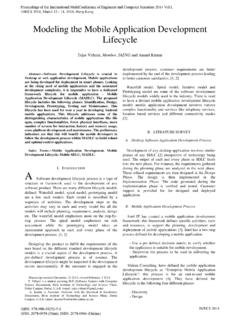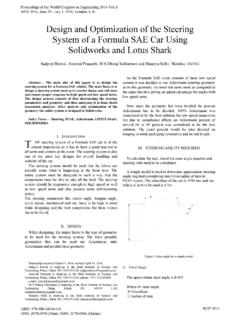Transcription of LOW COST HOUSING - TCE Consulting Engineers Limited
1 ACSGE-2009, Oct 25-27, BITS pilani , India 1 LOW cost HOUSING RINKU TAUR 1 and VIDYA DEVI T 2 1 TCE Consulting Engineers Ltd, New Delhi, 2 TCE Consulting Engineers Ltd, New Delhi, Abstract: This paper aims to point out the various aspects of prefabricated building methodologies for low cost HOUSING by highlighting the different prefabrication techniques, and the economical advantages achieved by its adoption. In a building the foundation, walls, doors and windows, floors and roofs are the most important components, which can be analyzed individually based on the needs thus, improving the speed of construction and reducing the construction cost . The major current methods of construction systems considered here are namely, structural block walls, mortar less block walls, prefabricated roofing components like precast RC planks, precast hollow concrete panels, precast concrete/Ferro cement panels are considered.
2 Keywords: Prefabrication; Precast RCC kular , precast joist, Ferro cement products Introduction Affordable HOUSING is a term used to describe dwelling units whose total HOUSING cost are deemed Affordable to a group of people within a specified income range. ( ) In India, the technology to be adopted for HOUSING components should be such that the production and erection technology be adjusted to suite the level of skills and handling facilities available under metropolitan, urban and rural conditions.( and , 2003) Logical approach for optimizing HOUSING solutions: There should be a logical approach for providing appropriate technology based on the availability of options, considering its technical and economical analysis.
3 1. There should be optimal space in the design considering efficiency of space, minimum circulation space. 2. Economy should be considered in design of individual buildings, layouts, clusters etc. 3. While preparing the specifications it should be kept in mind that, cost effective construction systems are adopted. 4. Energy efficiency has gained considerable importance due to energy crisis especially in developing countries. Orientation, built form, openings & materials play a vital role besides landscaping / outdoor environment. 5. To develop an effective mechanism for providing appropriate technology based shelter particularly to the vulnerable group and economically weaker section.
4 ( , 2008) Prefabrication as applied to `Low cost HOUSING ( and , 2002) Advantages of prefabrication are: 1. In prefabricated construction, as the components are readymade, self supporting, shuttering and scaffolding is eliminated with a saving in shuttering cost . ACSGE-2009, Oct 25-27, BITS pilani , India 2 2. In conventional methods, the shuttering gets damaged due to its repetitive use because of frequent cutting, nailing etc. On the other hand, the mould for the precast components can be used for large number of repetitions thereby reducing the cost of the mould per unit. 3. In prefabricated HOUSING system, time is saved by the use of precast elements which are casted off-site during the course of foundations being laid.
5 The finishes and services can be done below the slab immediately. While in the conventional in-situ RCC slabs, due to props and shuttering, the work cannot be done, till they are removed. Thus, saving of time attributes to saving of money. 4. In precast construction, similar types of components are produced repeatedly, resulting in increased productivity and economy in cost too. 5. Since there is repeated production of similar types of components in precast construction, therefore, it results in faster execution, more productivity and economy. 6. In prefabricated construction, the work at site is reduced to minimum, thereby, enhancing the quality of work, reliability and cleanliness.
6 7. The execution is much faster than the conventional methods, thereby, reducing the time period of construction which can be beneficial in early returns of the investment. Concept of prefabrication / partial prefabrication has been adopted for speedier construction, better quality components & saving in material quantities & costs .Some of these construction techniques & Materials for walls, roof & floor slab, doors & windows are as follows: In Walls:- In the construction of walls, rammed earth, normal bricks, soil cement blocks, hollow clay blocks, dense concrete blocks, small, medium and room size panels etc of different sizes are used.
7 However, bricks continue to be the backbone of the building industry. In actual construction, the number of the bricks or blocks that are broken into different sizes to fit into position at site is very large. which results in wastage of material poor quality. Increasing the size of wall blocks will prove economical due to greater speed and less mortar consumption, which can be achieved by producing low density bigger size wall blocks using industrial wastes like blast furnace slag and fly ash. Several prefabrication techniques have been developed and executed for walls but these medium and large panel techniques have not proved economical for low rise buildings as compared to traditional brick work.
8 ( and , 2002) i. Non erodable mud plaster: The plaster over mud walls gets eroded during rains, which necessitates costly annual repairs. This can be made non erodable by the use of bitumen cutback emulsion containing mixture of hot bitumen and kerosene oil. The mixture is pugged along with mud mortar and wheat/ rice straw. This mortar is applied on mud wall surface in thickness of 12 mm. One or two coats of mud cow dung slurry with cutback are applied after the plaster is dry. The maintenance cost is low due to enhanced durability of mud walls.( , 2008) Fig. 1. Mud Plastered House ii. Fly Ash sand lime bricks: By mixing of lime and fly ash in the presence of moisture, fly ash sand lime bricks are made.
9 Fly Ash reacts with lime at ordinary temperature and forms a compound possessing cementitious properties. After reactions between lime and fly ash, calcium silicate hydrates are ACSGE-2009, Oct 25-27, BITS pilani , India 3 produced which are responsible for the high strength of the compound. Bricks made by mixing lime and fly ash are therefore, chemically bonded bricks. The bricks are manufactured with the help of hydraulic press and are dried in the autoclave. These bricks have various advantages over the clay bricks, It possesses adequate crushing strength, uniform shape, smooth finish and does not require plastering and also are lighter in weight than ordinary clay bricks.
10 ( , 2008) iii. Solid concrete and stone blocks: This technique is suitable in areas where stones and aggregates for the blocks are available locally at cheaper rates. Innovative techniques of solid blocks with both lean concrete and stones have been developed for walls. The gang-mould is developed for semi-mechanized faster production of the blocks. In the manual process, single block moulds are used wherein the concrete is compacted with help of a plate vibrator. With the use of a portable power screw driven egg laying type machine, solid concrete blocks are made with higher productivity at low cost . Six blocks of 30 x 20 x 5 cm size are cast in single operation with an output of 120-150/hr.





